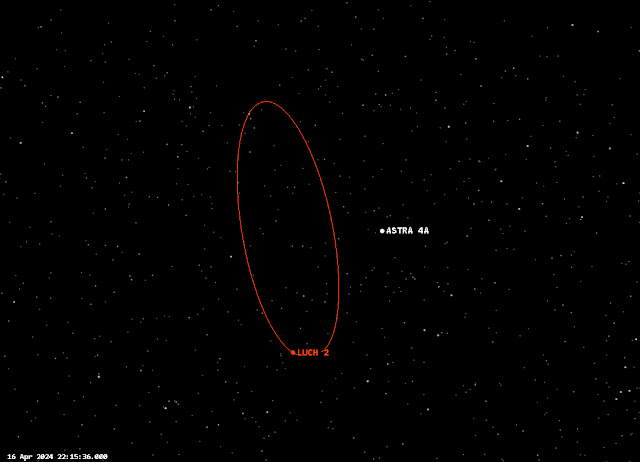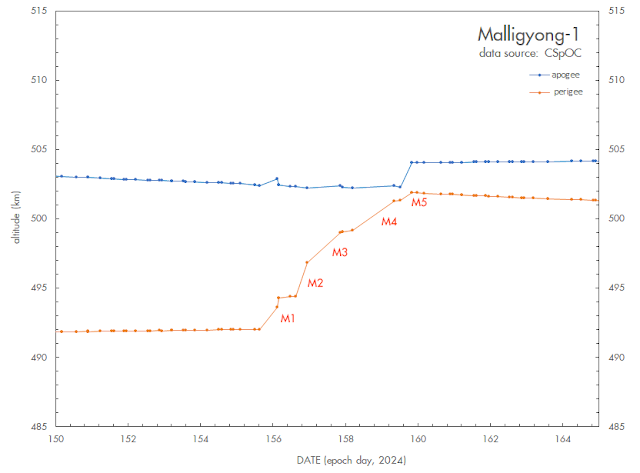(blogpost updated on June 6, June 14, June 17 and June 23, 2024. Last update at bottom)
The video above shows 2023-195A, the third mission of China's experimental spaceplane (aka "PRC Test Spacecraft", aka "Reusable Test Vehicle") and "Object G" (2023-195G), an object it ejected late May 2024.
The video was taken from Leiden, the Netherlands, in evening twilight of June 8, 2024, using a WATEC 902H2 Supreme camera and Samyang 1.2/85 mm lens.
Object G is the faint object in front, the brighter object is the Space Plane.
I had also observed both objects a day earlier, on the evening of June 7, in deep twilight. Below is a frame stack from that June 7 observation: object G is the fainter of the two streaks and was just in front of the Spaceplane:
Object G was first catalogued on May 25. My analysis shows that it was ejected from the Spaceplane on May 24 near 18:40 UTC, during a pass over China.
Directly after ejecting it, the spaceplane made a manoeuver, raising its orbit by about 1 kilometer. This likely was an avoidance manoeuver, i.e. a manoeuver to avoid hitting the object it just ejected.
In the first few days after ejection, the 18th STS appears to have confused both objects: orbital data for object G and the spaceplane between epoch 24146.6 and 24148.9 have been switched, and what is labelled as "PRC Test Spacecraft 3" in the catalogue during this period is actually Object G, and vice versa.
Below are two diagram of the apogee and perigee evolution for both objects: one "as is" following the catalogue identities: and a second one where I have corrected the identities of both objects during the period they were switched:
 |
click diagram to enlarge
|
 |
click diagram to enlarge
|
Looking at the orbital behaviour of both objects, it appears that Object G does not noticably manoeuver. Its parent the spaceplane did: between June 5 and June 7, starting eleven days after it ejected Object G, the space plane made a series of (phasing) manoeuvers, as can be seen in the diagram above. It first lowered its orbit, and then raised it again a day later. The result is an orbit at similar altitude and orbital period as Object G, but slightly more eccentric.
Another effect of those manoeuvers was that it brought the spaceplane and Object G in close spatial proximity again, with a separation of only a few kilometers (as can be seen in the video imagery in top of the post, taken when both objects were some 7-8 km apart). It is possible that the spaceplane did briefly retrieve Object G or attempted to do so, and then let it go again, but this cannot be unequivocally confirmed from the orbital data. Some combinations of the orbital data for epoch 24160 do suggest that a potential very close approach at kilometer level or even less might have happened on 8 June near 14-15h UTC. The rapid manoeuvering evident from the clear orbital changes in successive elsets from June 8-9 makes it however difficult to validate true distances and exact times involved.
It is clear however that between June 5 and 7, the spaceplane manoeuvered with the intent to do a proximity operation with Object G on June 8, bringing the two objects to within a few kilometers of each other.
It will be interesting to see whether or not the spaceplane will
periodically adjust its orbit to remain in the vicinity of Object G. [see update at bottom of post!]
The spaceplane was launched from Jiuquan with a Long March 2F rocket on 14 December 2023, initially into a 348 x 332 km, 50.0 degree inclined orbit. On January 5, it made a small orbit raise to 359 x 331 km. On 19 January 2024, it significantly raised its orbit to 597 x 334 km. On 26 January 2024, it circularized its orbit to 609 x 602 km (see diagram of orbital evolution below). On May 24, it spawned Object G.
 |
click diagram to enlarge
|
The spacecraft is a robotic spaceplane capable of landing on a runway after deorbit, and China's answer to the US X-37B OTV spaceplane. It is launched on a rocket from Jiuquan, and after spending time on orbit, it lands again on a 5-km long runway near Lop Nur in the Taklamakan desert (see Sentinel satellite image below).
 |
Lop Nur runway (Sentinel 2B image). Click to enlarge
|
The current mission is the third mission of this type of spacecraft: it did a short 2-day mission in August September 2020, and a much longer 276-day mission between August 2022 and May 2023. The current mission has been on-orbit for 181 days (status June 12, 2024).
UPDATE 14 June 2024
On June 11 near 9 UTC and June 12 near 10 UTC, the spaceplane again made phasing manoeuvers, followed by a series of smaller orbit adjustments that have now brought apogee and perigee altitudes (and with that eccentricity and orbital period) very close to those for Object G.
The June 11 and 12 manoeuvers caused another very close approach (to a km or less), i.e. another proximity operation, between the spaceplane and Object G on June 12 near 13 UTC.
 |
click diagram to enlarge
|
UPDATE 17 June 2024
The spaceplane keeps manoeuvering for new proximity operations with object G. A new close approach (a kilometer or less) was made on June 14 near 10:08 UTC, a next one might have happened on June 16 near 5:40 UTC, and another one might occur within hours of posting this update, on June 17 near 13:12 UTC.
 |
click diagram to enlarge
|
UPDATE 23 June 2024
While the dates are generally reliable, the exact approach times I earlier listed might on hindsight not always be that accurate (hence why I crossed them out in this post update). The spaceplane likely frequently made orbit adjustments, and not all of those are well captured by the available tracking data. The approach times calculated depend clearly on which set of orbits you take, even for epochs close together in time.
The orbital periods of both objects - spaceplane and object G - are now very similar, and as a result they stay in each others vicinity, at a general distance of about 100 km at the time of writing (June 23), a distance which is very slowly increasing over time. The spaceplane's orbit is slightly more eccentric than that of object G.
 |
click diagram to enlarge
|
There is an interesting pattern in the inclination of the object G orbit data, but I am not certain whether it is real or an artefact. There are minute 'jumps' in the inclination of object G that appear to coincide with dates of close approaches by the spaceplane. Given the earlier initial confusion between the object A and G identities, I remain cautious on whether or not these are significant.


















